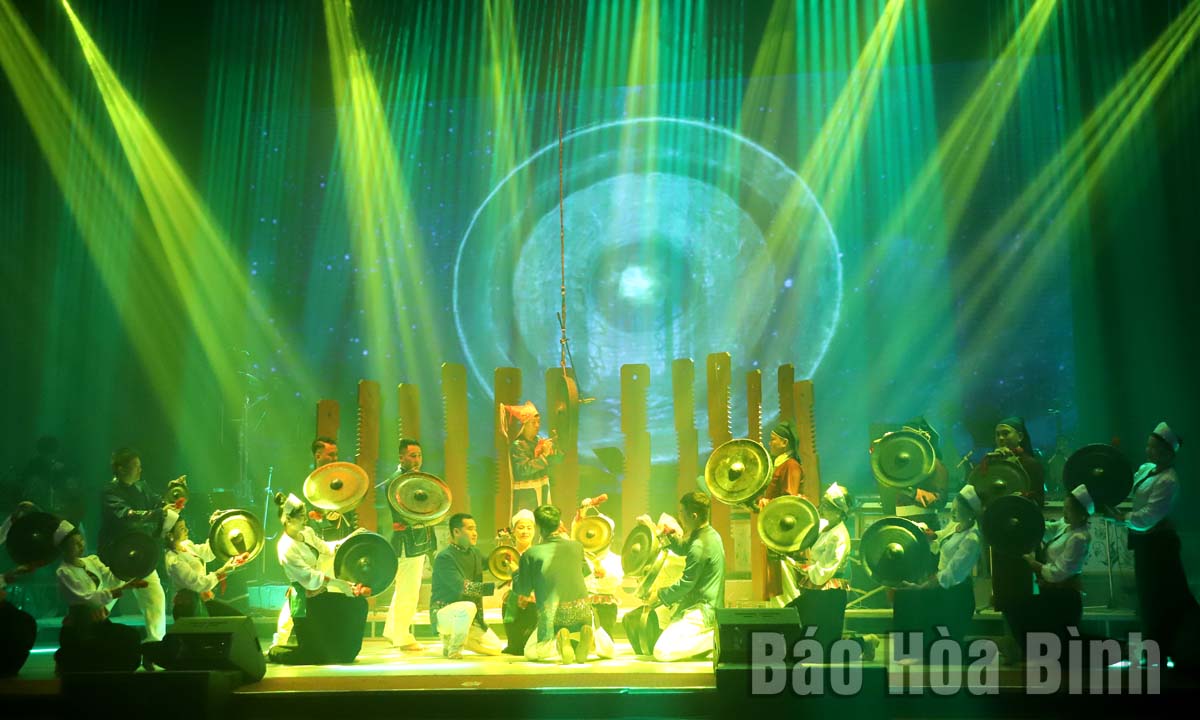
(HBO) - On June 26 evening, at the Cultural Palace of Hoa Binh province, the Department of Performing Arts, in collaboration with the Vietnam Musicians' Association and the Department of Culture, Sports and Tourism of Hoa Binh province, held the closing and awarding ceremony of the 2023 National Traditional Musical Instrument Solo and Orchestra Competition.
The competition was held in Nha Trang city, Khanh Hoa province, from June 10-14, and in Hoa Binh city, Hoa Binh province, from June 20-26, drawing the participation of nearly 1,500 artists from 39 troupes across the country with 190 solo and ensemble performances. In 11 days of competition, artists and musicians brought to music-lovers impressive performances that not only showed the quintessence of traditional music, but also contained valuable historical and cultural values of Vietnam’s ethnic groups.
The "Chieng Muong thuc giac” performance by the Ethnic Art Troupe of Hoa Binh province wins a second prize.
Traditional art troupes clearly showed their regional and local music characteristics, while music and dance ones demonstrated their modernity in bringing Western instruments, vocals or other effects to support traditional musical instruments. With a length of 30-45 minutes for both solo and ensemble performances, each unit introduced to the audience its unique musical features.
The Ministry of Culture, Sports and Tourism awarded 30 first, 51 second and 12 third prizes. Meritorious artist Tran Quoc Dat of the Military Music and Dance Theatre was granted the excellent conductor title, while Son Si Phone of the Khmer Anh Binh Minh Art Troupe in Tra Vinh province won the best musician award.
The Vietnam Musicianss Association awarded certificates of merit to 18 outstanding figures in instrumenting, performing, rising stars and musicians who made great efforts in the competition./.
With an increasingly vibrant and widespread emulation movement aimed at building cultured residential areas and cultured families, Yen Thuy District has been making steady progress toward improving both the material and spiritual well-being of its people, while fostering a civilized, prosperous, beautiful, and progressive community.
Once lacking recreational spaces and community facilities, Residential Group 2 in Quynh Lam Ward (Hoa Binh City) has recently received attention for the construction of a new, spacious, and fully equipped cultural house. The project followed the model of state support combined with public contributions in both labor and funding.
The "All people unite to build cultural life" movement, which has been effectively integrated with Kim Boi district’s socio-economic development goals, is fostering a lively spirit of emulation across local residential areas, hamlets, villages, public agencies, and enterprises. In addition, through the initiative, traditional cultural values are being preserved and promoted, while community solidarity and mutual support in poverty reduction and economic development are being strengthened.
A working delegation of the Hoa Binh provincial People’s Committee led by its Permanent Vice Chairman Nguyen Van Toan on June 11 inspected the progress of a project to build the Mo Muong Cultural Heritage Conservation Space linked to tourism services in Hop Phong commune, Cao Phong district.
Born and growing in the heroic land of Muong Dong, Dinh Thi Kieu Dung, a resident in Bo town of Kim Boi district, in her childhood was nurtured by the sweet lullabies of her grandmother and mother. These melodies deeply imprinted on her soul, becoming an inseparable part of her love for her ethnic group's culture. For over 20 years, this love for her hometown has driven Dung to research, collect, and pass down the cultural values of the Muong people to future generations.
In the final days of May, the Ethnic Art Troupe of Hoa Binh Province organized performances to serve the people in remote, mountainous, and particularly disadvantaged areas within the province. These were not just ordinary artistic shows, but they were the meaningful journeys aimed at spreading cultural values, enhancing the spiritual life of the people and contributing to the preservation of ethnic minority cultural identities.



